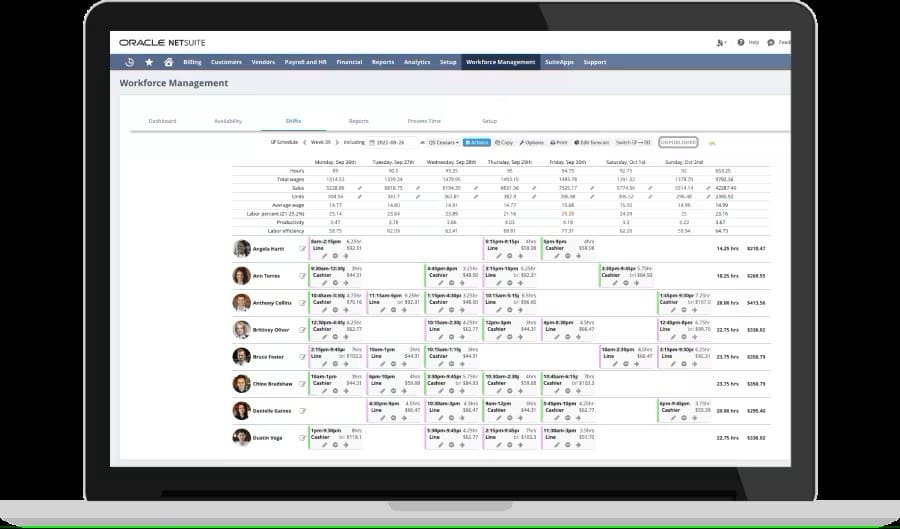Because talent is such a crucial asset for any business, workforce planning is one of the most important factors in organizational growth. Unfortunately, many organizations still don’t fully understand their current and future workforce needs. This can severely limit a company’s ability to reach key goals, stunting growth.
With well-executed, strategic workforce planning, companies can more accurately predict needs to better ensure resources are used in the right place at the right time.
What Is Workforce Planning?
Workforce planning is a process that helps to ensure the right person is in the right position at any given time. It requires an organization to analyze, forecast, and plan out its future staffing needs while factoring in whether existing employees or outside talent can fill those needs. This focus on planning typically requires talent management solutions to help make those determinations and fulfill its business objectives.
Key Takeaways
- Effective workforce planning requires managers to combine data analysis, forecasting tools, and strategic decision-making to place the right talent in the right place at the right time in line with the business’s needs.
- Successful employee management balances strategies for short-term staffing gaps with long-term employee development.
- This balance is best struck by prioritizing critical roles that have the most significant impact on success while developing comprehensive training and succession policies.
- Businesses should address skills gaps with strategies that align with their specific operational goals and budgetary constraints.
- These strategies include developing internal staff, hiring external experts, and outsourcing processes.
Workforce Planning Explained
Workforce planning strategies are built using a combination of data analytics and forecasting tools to give decision-makers the clearest picture of their upcoming needs and how best to meet them. Modern businesses typically use specialized software to gather and analyze diverse workforce data, including labor allocation, turnover rates, productivity and cost metrics, and labor market trends. These tools are often integrated into existing HR systems to let managers create detailed models of their current capabilities and project future labor needs based on both short- and long-term objectives. Long-term targets are often established through collaboration among human resources (HR) teams, department managers, and executive leadership, ultimately creating a comprehensive and forward-thinking approach to worker hiring, training, and allocation that addresses each department’s needs. Here are three common workforce planning strategies.
Strategic Workforce Planning
Strategic workforce planning prioritizes long-term organizational goals, typically looking three to five years ahead. This approach aligns staffing decisions with broader business strategies, such as planned market expansions, product developments, or investments in new digital tools and business platforms. Leaders use strategic workforce planning to predict which skills will help reach future business goals, then develop talent pipelines and training programs to foster those skills. For example, a manufacturing company planning to automate assembly processes over the next two years can use strategic workforce planning to determine what new technical skills its workforce will need for proper implementation and maintenance of the new technology, as well as how to acquire and develop that talent for a prepared workforce upon deployment.
Operational Workforce Planning
Operational workforce planning focuses on practical steps to address immediate to medium-term staffing needs, such as the upcoming year. This process may include bringing in temporary workers to address short-term skill gaps and changing how managers schedule shifts. Short-term planning helps businesses manage their day-to-day operations while maintaining enough flexibility to address unexpected changes in workforce needs, such as demand spikes. Operational plans often consider seasonal and project-based staffing needs when reorganizing or expanding teams.
Workforce Planning and HR Analytics
Workforce planning can be considered one piece of HR analytics, which businesses use to shape their people management strategies. While strategic workforce planning focuses on the long-term initiatives behind hiring and retaining employees, people or talent analytics concentrates on evaluating relationships between talent and business outcomes. Additionally, HR analytics monitors key metrics over time, such as turnover patterns, skill gap analyses, and productivity measurements to help companies understand the impact of workforce strategies and inform future efforts.
Why Is Workforce Planning Important?
Talent management is a persistent challenge for any organization, but workforce planning helps to minimize—and where possible, eliminate—current and future staffing issues. For example, an aging workforce can create talent shortages for certain roles due to mass retirement and a lack of appropriate skills. Considering skilled workers can give an organization a competitive edge; hiring and keeping employees who are both ambitious and skilled creates a pipeline to replace departing staff, ensuring long-term success.
Businesses today must innovate faster than ever before, and they need talented employees who can handle those demands. This forces organizations to work more efficiently, finding ways to keep costs down (including the expenses that are a product of an aging workforce), and maximize their budget without compromising quality.
Principles of Workforce Planning
The principles of workforce planning serve as foundational guidelines for developing and implementing staffing strategies. The following core principles help decision-makers align workforce planning efforts with practical and realistic objectives that make the most out of available resources. However, keep in mind that specific strategies should be crafted with the business’s specific needs and goals in mind.
- Align the plan with company objectives or strategy: Consider how each staffing decision will impact immediate staffing needs and support broader goals over the next five to 10 years, including expanding offerings or reaching new revenue targets. This alignment helps companies meet current demand and prevents disconnects between hiring decisions and other growth strategies, such as new technology or capital investments, to best serve the business’s overall objectives.
- Take a long-term view: Make tactical decisions that balance immediate staffing needs and cost considerations with future talent requirements. This forward-looking approach helps businesses prepare for both expected and unforeseen market changes by creating a well-trained and flexible workforce that can adapt as technology and industries evolve. Diverse and comprehensive training programs, talent pipelines, and ongoing continuous education for veteran staff help companies prepare as new needs arise.
- Focus on your company’s most important roles: Prioritize critical roles to maximize the impact of any strategic improvements. Management consultant Joseph M. Juran’s Pareto Principle states that 80% of results stem from 20% of causes, explaining that a company’s “vital few” resources have a disproportionate effect on its overall success or failure. Businesses can use this principle to identify which positions most directly impact performance and make sure these roles receive appropriate attention. Once these critical positions are properly handled, managers can then move on to what Juran calls the “useful many”—factors that have a minor effect on performance.
Benefits of Workforce Planning
Effective workforce planning ensures that a company is not simply reacting to risks like a talent drain from retirements or employee attrition. This process is a constant strategic evaluation of how talent risk can impact an organization’s finances, product development, and customer relationships.
Benefits of workforce planning include:
- Metrics that allow leadership to identify risks before they impact the organization’s goals.
- Tools and reports that articulate the impact of decisions for better management over future investments in your workforce.
- A clear view of supply and demand challenges by location and expenses.
- Identifying and rectifying issues that may limit productivity.
- A competitive advantage.
- Consistent reports of outcomes to assess meaningful and measurable results.
Workforce Planning Process
The workforce planning process starts with establishing basic guiding principles and then following an ordered list of steps. This not only gives your team a roadmap to follow and keeps you organized, it also increases the effectiveness of this initiative.
Since the workforce plays a central role in an organization’s future, the following steps can ensure that your workforce planning strategy aligns with your broader vision for the company.
-
Supply Analysis
This stage examines how your current and future workforce may change due to trends, such as attrition or market growth. Consider how well the existing workforce supports your current strategy, the number of employees at each level, the difficulty of filling certain positions, and whether any local talent pools or recruitment partners can provide the specific talent in need.
-
Demand Analysis
This stage assesses your company’s current and future talent requirements. Consider the number of staff needed to complete key tasks, any anticipated changes in regulations or policies impacting your business, opportunities to leverage resources, and how the organization’s workload could change.
-
Gap Analysis
This stage compares supply and demand to identify workforce gaps, then prioritizes the most critical ones. Consider how the business can address these gaps to remain competitive, what jobs have hard-to-find skills, how retirement affects employee numbers, and how to improve workplace diversity.
-
Solution Analysis
This stage implements activities and interventions to close your workforce gaps and ensure your organization meets its goals. Consider how to develop planning capabilities, how to use data to identify action steps, what metrics best monitor risks, and the biggest workforce planning needs.
You’ll also need to examine different staffing options. Here are a few strategies to address workforce gaps.
- Contract specialized consultants: Rely on experts and contractors with specific skills, such as accountants, tax specialists, and project planners, for short-term projects or to address temporary skill gaps while recruiting and training new staff. This approach provides access to specialized talent without the long-term commitment of full-time hires, especially for highly skilled tasks outside of usual operations.
- Improve employee training: Build up existing staff’s capabilities through targeted training programs, continuing education, and skills development initiatives. By introducing new skills in existing talent, businesses can fill skill gaps internally and improve employee retention and job satisfaction.
- Increase recruiting efforts: Expand talent acquisition strategies by using multiple channels to bring in new talent with diverse skills. These channels include professional networks, such as job boards and recruitment agencies, as well as internship programs and partnerships with educational and community institutions.
- Hire part-time employees: Use part-time staff to address variable workload demands throughout the day, week, month, or season. Part-time and flexible scheduling allow businesses to scale their workforce capacity based on fluctuating needs without ballooning labor costs.
- Sign on temp staffers: Bring in temporary workers to handle seasonal peaks and special projects or to cover extended employee absences. Temporary employees can offer immediate workforce solutions without long-term commitments, but they often require training and onboarding to get them up to speed with standard operating procedures.
- Outsource noncore functions: Transfer secondary business activities to external service providers, such as third-party logistics or payroll companies, to reduce operational costs and free up staff to focus on core competencies.
Workforce Planning Example
Let’s say a company has two different product lines and is debating whether to add a third. Sales for the first product line are slowly declining, whereas the second one is taking off, with forecasts predicting continued growth.
Using data such as current revenue, expected annual growth, and the number of sales and support staff, leaders can settle on a goal for revenue in the upcoming year. This is a simplified way to assess how staff should grow based on these goals and current data.
Assuming staffing costs are equal for both product lines, it’s safe to think the first product line isn’t as profitable. Therefore, there probably isn't a need to increase staff. If there are "excess" workers, then they work on the second product line, assuming their skills remain relevant there (if not, the business could consider retraining them). Leaders can also plan and retrain employees anyway, anticipating future needs for the second product line, reducing hiring costs.
Based on the numbers, leaders also predict the second product line will remain more profitable. The organization can then look at the growth percentage to estimate the number of additional staff required to support that rise. These hires can happen immediately or gradually depending on how these projections play out.
Keep in mind that this is a simple example that only includes a few basic factors. More information will make your plan more useful and relevant, but also more complex.
6 Tips for Effective Workforce Planning
To effectively implement workforce planning, HR leaders need to be inquisitive and strategic and collaborate with executives from across the organization. A plan should be tied to your company’s overarching objectives and include all relevant factors that potentially impact your hiring and employee management.
Here are six steps you need to take to create an effective plan:
- Establish concrete current and long-term business objectives. The more concrete and detailed you can get with your business objectives, the better. That way, you’re able to identify and measure the most relevant metrics after you launch this effort.
- Lean into HR analytics. People analytics can offer insights into your current workforce, looking at your employees' demographics, work contracts, and seniority profile. You can also see the performance and quantity of staff members on hand.
- Identify skills gaps. Analyzing skills gaps allows you to anticipate long-term needs and related potential challenges. This can provide a head start in finding possible solutions, like training existing employees to cover the gaps, hiring more workers, or shifting to a different employment model.
- Conduct workforce scenario planning. It’s impossible to be ready for every contingency, so preparing for different scenarios is key. Model different scenarios that could potentially impact your business and determine what that might mean for your workforce.
- Ask for outside advice. Leaders can lean into their network and seek out the advice of others who are in similar positions. They can also hire outside help, such as a consultant who specializes in strategic workforce planning. This person can work alongside you for parts or all of the project.
- Monitor your plan. Your workforce strategy is a fluid plan, and real-time monitoring provides insights to make quick adjustments based on what you’re seeing as necessary.
Free Workforce Planning Template
Use our free workforce planning template (opens in new tab) to help you determine the strategic direction your business needs to take when it comes to hiring and managing employees.
Role of Succession Planning in Workforce Planning
Succession planning is the process of identifying and developing employees to fill key leadership positions or other critical roles as they’re vacated. Succession planning helps maintain business continuity and knowledge retention as staff retire, move to new roles, or leave the company. By proactively preparing internal candidates, businesses can reduce the risks associated with sudden departures and ensure a smooth transition of responsibilities. Additionally, succession planning fosters employee engagement and career development, as it signals to high-potential individuals that the company is invested in their professional growth.
How Human Capital Management (HCM) Systems Can Help
Human capital management systems are software solutions that businesses use to strengthen workforce management practices throughout the entire employment cycle. This includes every step from initial recruitment and onboarding to performance management and retirement planning. HCM systems automate much of the data gathering process and offer valuable insights, such as productivity analytics and employee progress against individual goals. This information can make the workforce planning process much more feasible and less daunting as operations scale.
Choosing the Right HCM
When choosing an HCM system, finding the right fit means looking at the type of data you need to ensure a more thorough and effective planning process. While most HCM systems store basic data, such as the number of employees and payroll information, businesses should look for solutions that are more robust with a goal of taking advantage of additional functionality as they grow. Look for a system that can run user-defined reports and map out multiple workforce scenarios so you’re more prepared.
Manage Your Workforce Efficiently With NetSuite SuitePeople
Finding the right balance between staffing needs and labor costs can be a challenge for any company, especially those with a growing workforce and fluctuating demand. NetSuite SuitePeople provides businesses with a comprehensive human resource management system that enhances workforce planning through automated data collection and powerful reporting tools. By creating a centralized database for employee data, including directories, performance metrics, scheduling, and payroll, managers can accurately forecast short- and long-term staffing needs by identifying skill gaps and developing targeted management strategies. Additionally, the system's recruitment and onboarding features help bring in new talent, ands built-in succession planning and employee recognition tools help address ongoing leadership challenges.
As part of NetSuite’s unified and customizable platform, SuitePeople enables HR teams to align workforce planning with broader objectives and budgets through real-time KPI monitoring and analytics capabilities. This integrated approach empowers leaders to make more informed decisions about hiring, training, and resource allocation to create a flexible workforce as their needs change.
NetSuite’s Workforce Management Dashboard

While it’s a complex process that requires a lot of time and thought, workforce planning is well worth the effort. It gives your business a competitive advantage to better prepare for the future and avoid scrambling when needs arise. Managers can make data-driven decisions based on a role’s importance and individual performance, and the business can evaluate the impact of different work. Ultimately, workforce planning aims to help businesses put the right people in the right jobs at that time. It means leaders need to understand their current workforce, plan multiple future scenarios, and determine their business objectives.
Simplify
HR and Payroll
Workforce Planning FAQs
What is the goal of workforce planning?
The goal of workforce planning is to ensure the right amount of people are in the right position at the right time. This allows an organization to work more efficiently and effectively and is especially beneficial for larger companies.
What are the steps in workforce planning?
Workforce planning involves finding gaps between future organizational needs and your current workforce. It consists of four key steps: supply analysis, demand analysis, gap analysis, and solution analysis.
How does workforce planning improve productivity?
Workforce planning enables businesses to respond more strategically and nimbly as leaders see needs develop, whether due to changes in their industry, organization, or the working population at large. It also ensures that workers have the relevant skills and knowledge needed to be a good fit for and excel in their position.









